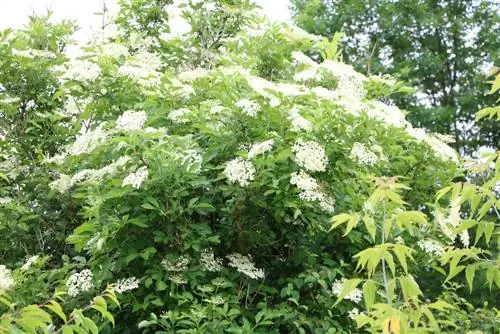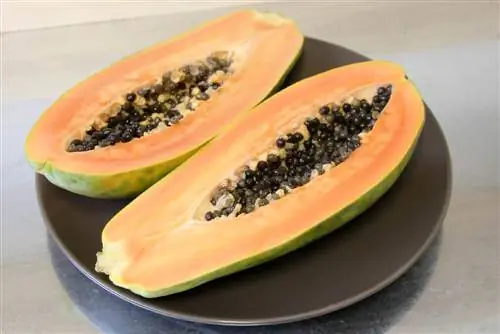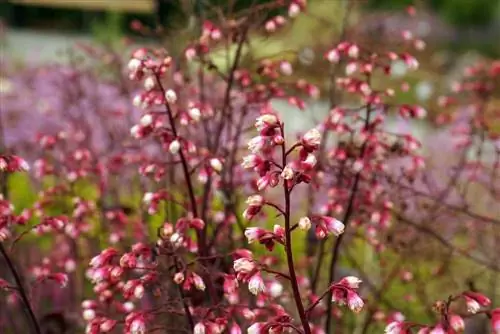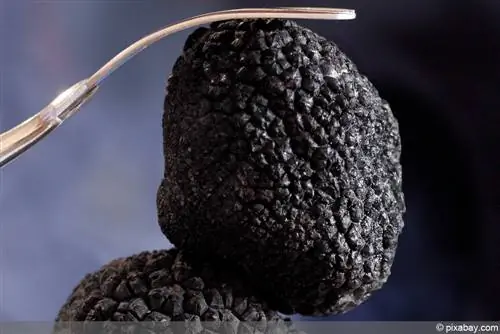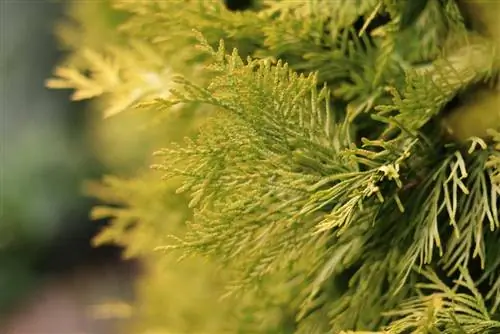- Author admin [email protected].
- Public 2023-12-17 03:39.
- Last modified 2025-01-24 12:45.
If you still have a place in the shade on the north side of your house, or if there is still room for a smaller tree under a very large tree, you can be happy because there are enough trees and trees that also grow in the shade. However, a dark location can affect growth and eventual flowering. The list provides information about shade-tolerant trees and shrubs.
Shade trees from B to K
Berberis
Berberis is particularly popular as a narrow hedge plant. Due to its shade tolerance, it is also the ideal tree for any shady location as a solitary plant. Barberries also have the following properties:
- easy to cut
- can also be kept small
- Flowering between May and June
- berries develop from this
- very soil tolerant
- City Climate Festival
Tip:
Many species of barberries are known, which also differ greatly in appearance. Trees with red or yellow leaves are also available, such as the best-known, the common barberry.
Boxwood
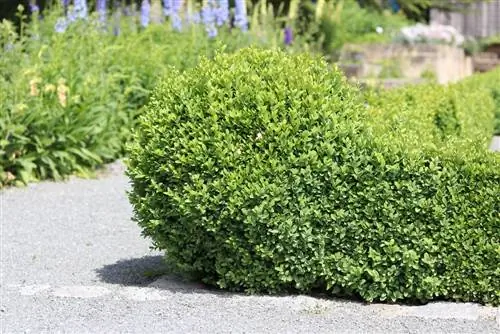
The evergreen boxwood is a small tree that usually grows up to one meter high. It can grow up to one and a half meters wide. It is therefore suitable as a wind and privacy screen, for example near the terrace. Since it tolerates shade well but can also tolerate sun, it can be cultivated in any location. It also has the following properties:
- slow growing
- easy care
- is often used as a bed border
- also often used as grave planting
- bright blossom in spring
rowan tree
The mountain ash is also known as the rowan tree and belongs to the Rosaceae family. If cultivated as a solitary tree, the tree can reach a height of between three and twelve meters. The shade-tolerant mountain ash has the following properties:
- leaves pinnate
- yellow to red autumn color
- deciduous in winter
- white flowers in May and June
- This is where the berries form in autumn
- not edible but non-toxic
- popular tree with birds
- good soil tolerance
- needs large amounts of water
Tip:
The rowanberry is the ideal tree for anyone who is looking for a tree for shade in the garden that is, above all, easy to care for and adaptable.
Rock Pear
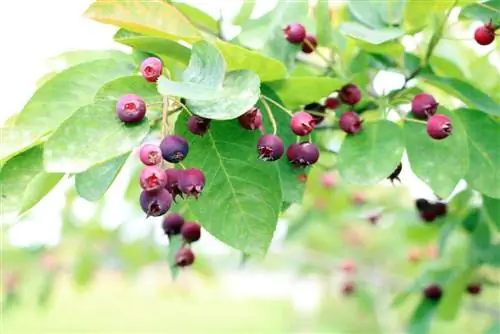
The common or true rock pear is becoming increasingly popular, especially in natural gardens. The shade-tolerant tree can be used to create beautiful accents even in a rather unattractive location. Because the rock pear has the following properties:
- white flower clusters in spring
- black fruits in July
- edible
- densely branched and upright growing
- red leaves in autumn
- deciduous in winter
- Height between one and a half and three meters
- Width between two and three meters
- Soil demands low
Tip:
The common rock pear is particularly suitable for gardens where snacking is allowed. Due to the edibility of the fruit directly from the tree, it is also suitable for families with children.
elderberry
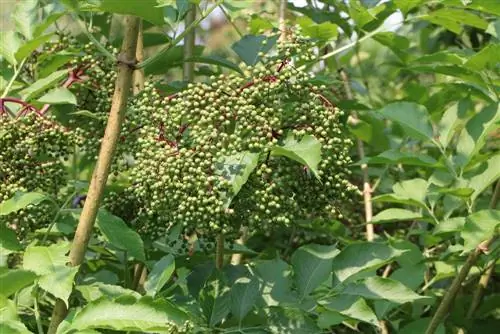
The elderberry was already highly valued in gardens in ancient times. It can still be found in many cottage gardens today. In addition, the flowers and fruits of the tree are very versatile. The elderberry tolerates shade well, but can also tolerate sun and is therefore suitable for almost any location in the garden. It has the following properties:
- white, small flowers on flower plates in early summer
- edible
- Fruit clusters develop in late summer
- small black berries
- prefers moist, loamy soils
- prune regularly for a good harvest
- Crown branches at a height of one meter
Tip:
Flowers and fruits are not only edible, they are also highly recommended for the medicine cabinet in many ways, as they are said to have many good healing properties.
Cherry Laurel

The cherry laurel can reach a height of up to three meters and a width of up to one and a half meters if it is given enough space as a solitary plant. It is often planted next to a terrace as a wind or privacy screen. It can also be shady here for the cherry laurel. The other properties of the easy-care plant are as follows:
- no loss of appearance in the shade
- adaptable and undemanding
- fresh look thanks to grass-green leaves
- Bloom in May
- white flowers on upright clusters
- evergreen
- Color accent for dreary winter garden
- easy to cut
Cornelian cherry

If you only have a little space in the shade, you can also choose the relatively small cornelian cherry. The tree grows up to half a meter high, but can be up to three meters wide. The shade-tolerant tree comes in many different colors throughout the year:
- golden yellow flowers in spring
- late in August red fruits
- these become dark-black-red over time
- are then edible
- green leaves
- turn red-orange in autumn
- deciduous in winter
Shadow trees from L to Z
Privet
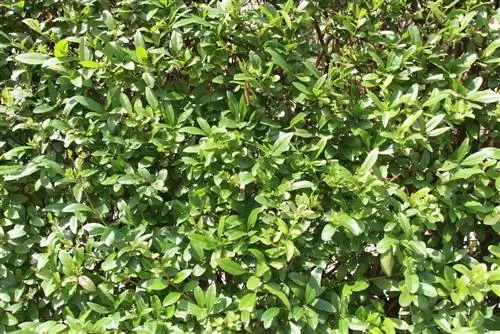
The privet is considered to be very robust and undemanding and can thrive in almost any location, including a shady one. The shade tree grows between two and a half and five meters high and is well suited as a solitary plant. Above all, privet has the following positive properties:
- easy to cut
- high growth rate of 15 to 30 cm per year
- ovoid, medium green leaves
- Leaves are not replaced until spring
- wintergreen
- white flower spikes in spring
- shiny black berries in summer
- Bird food
- Good nesting opportunities for birds due to the density of leaves
Plane tree
The plane tree can grow up to thirty meters high, which is why it is usually used for streets and parks in these latitudes. However, it can also find its place in a shady place, for example on the north side of a house. However, the trunk is relatively short, so that the branches can be cut back if the tree has become too tall. Otherwise the plane tree has the following properties:
- Blossom in early May
- buds are already appearing on the leafless tree over the winter
- male flowers very small and yellow-greenish
- female flowers carmine red
- Fruits form in autumn that stay over the winter
- inedible
- Deep-rooted, therefore deep, sandy to loamy soil
Tip:
Of course, the plane tree can only be used to a limited extent in a garden. However, if you have a lot of space, you can cultivate the decorative tree.
Horse Chestnut
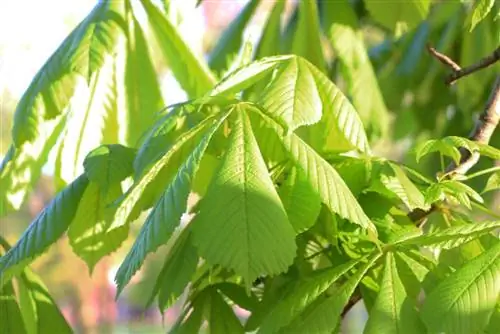
Every hobby gardener knows the horse chestnut from their childhood because of its reddish, round fruits. The tree can grow up to thirty meters high and is therefore only suitable for a garden to a limited extent. Nevertheless, it is well suited for the shade on a north side of the house. The horse chestnut has the following properties:
- reddish-brown fruits
- inedible
- the fruits are smaller in the shade
- reacts sensitively to road s alt in winter
- choose deep and well-drained soil
- can also be cultivated as a bonsai
- easy to cut
Tip:
The horse chestnut is also not necessarily recommended for a garden. Anyone who plants a small tree must be absolutely aware of the expected size in terms of height and crown circumference when planting it and therefore not plant the tree in the immediate vicinity of a house or a wall.
Daphne
Daphne is known for its early flowering. It belongs to the genus Daphne, which translated from Greek means laurel. But not every type is suitable for using the leaves in the kitchen. The tree has an upright habit and does not grow taller than two meters even when it is old. Daphne has further properties as follows:
- Flowering in spring to early summer
- white or pink flowers
- often exude an intense scent
- red stone fruits are ripe in June
- unfortunately not edible as it is very poisonous
- Be careful with small children in the household
- are very attractive to them
- only a few fruits can be fatal
- fresh, well-ventilated soil
- only cut a little
Tip:
The rosemary daphne variety is also very suitable for a rock garden, where it can also stand in the sun, but a little shade is still pleasant here.
Black Cherry
The bird cherry is an ornamental cherry whose fruits are usually not edible. Nevertheless, it offers an attractive eye-catcher in the garden and can also be cultivated in a shady location. As a tree, the black cherry reaches a height of up to fifteen meters over time. Above all, caution is advised here, as the tree likes to multiply in the wild. Therefore it needs to be cut back regularly. The bird cherry also has the following properties:
- forms underground runner roots
- In contrast, install a rhizome barrier directly when planting
- particularly good for bees due to pollen and nectar value
- white flower spikes with a strong scent in spring
- Fruits are pea-sized and poisonous
- but are used for jam, schnapps or flavoring
- need moist substrate
- is often found in the undergrowth in the wild
Magic Haze
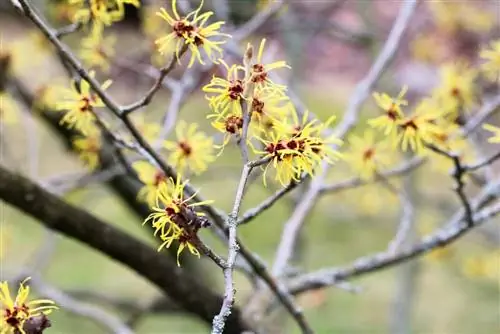
Witch hazel is also known to many as witch hazel, especially from creams and ointments. Due to its relatively small size of three meters, the shade tree is also well suited for small gardens and can find a sunny as well as a shady location. It becomes a decorative eye-catcher in the dreary winter garden because it is a winter bloomer. The witch hazel also has the following properties:
- bright orange flowers
- stringy
- exude a pleasant scent
- blooms between January and February
- Protect in heavy frost and snowfall
- the green leaves turn yellow to orange in autumn
- deciduous
- the fruit capsules ripen in late autumn
- the demands on the soil are high
Tip:
The witch hazel is quite undemanding in terms of care; the tree hardly needs any pruning. Only slight corrections are recommended here.
Cotoneaster
The cotoneaster has many uses in local gardens and can be cultivated as a ground cover, as a hedge and as a tree up to fifteen meters high. If it is cultivated in a shady location, then there are often not as many flowers. Otherwise, the cotoneaster has the following properties:
- normal garden soil is ideal
- a decorative eye-catcher all year round
- Flowering time in spring
- pink or white racemose inflorescences
- striking fruits in summer
- remember red apples
- colorful leaves in autumn
- does not require fertilization
- cutting evergreen cotoneasters
- no cutting necessary for leaf shedders

